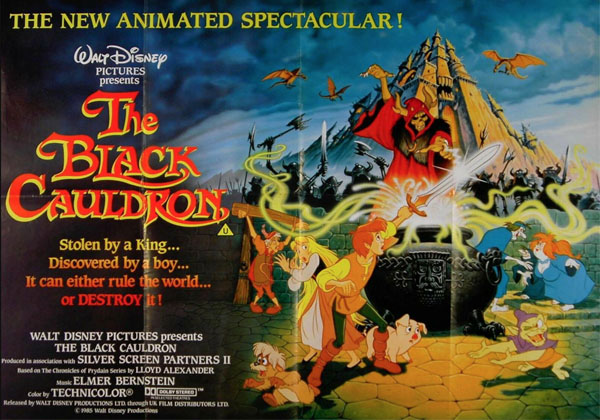
Suspended Animation #275
Disney animation is filled with witches from the 1932 Silly Symphony Babes in the Woods to the Wicked Queen in Snow White and the Seven Dwarfs to Mad Madam Mim in The Sword and the Stone and even Magica de Spell in DuckTales.
Disney’s live action films like Hocus Pocus, Halloweentown and Bedknobs and Broomsticks also feature witches who are beloved by Disney fans. However, one trio of Disney witches get no love at all perhaps because they appear in The Black Cauldron (1985), a troubled animated feature that gets no love either.
In just about any other Disney animated feature film the witches might have become eccentric supporting characters who gave an audience a brief respite of humor.
 Deep in the dreary marshes of Morva, surrounded by sickly mist and twisted, decaying landscaping, sits the ramshackle cottage of the three powerful witches of Morva who live alone in this forsaken place. The cluttered interior is in dusty disarray and hides many of the dark secrets of these sinister sisters.
Deep in the dreary marshes of Morva, surrounded by sickly mist and twisted, decaying landscaping, sits the ramshackle cottage of the three powerful witches of Morva who live alone in this forsaken place. The cluttered interior is in dusty disarray and hides many of the dark secrets of these sinister sisters.
Concealed among a towering pile of rusty kettles and battered pots is the terrifying Black Cauldron. When evil Arawan broke his pledge to return it after creating his army of zombie warriors, he paid a severe price: the angry enchantresses reclaimed it themselves and once again secured it safely in their forest hovel.
In the original book by author Lloyd Alexander, the hideous threesome had an age-worn loom and were meant to resemble the famous Fates of Greek mythology who controlled the destiny of every person alive with the tattered threads on their ancient loom. As one of the Fair Folk says to the heroic Taran, “It’s more a question of what they are, not who they are.”
“We’re neither good nor evil. We are simply interested in things as they are. Care isn’t really a feeling we can have,” claims the ugly Orddu in the book.

These sheets are drawn by Andreas Deja
Forceful Orddu, with her straggly crimson hair frantically seeking escape from the prison of her small simple headband, is the dominating leader of this terrible trio. Physically, she is the tallest with a plump torso, but oddly scrawny arms and bony legs that flail wildly as she talks. Her long pointed nose protrudes outward like a warty spike above her toothless grin. She passionately craves Taran’s powerful sword and furiously sulks at the end of the film when the other two witches offer it back to the disheartened Taran.
Hunched over Orgorch, wearing the traditional pointed witch’s hat, is the most disagreeable of the three mystical hags, constantly at odds with the desires of her siblings. Half as tall as Orddu, Orgorch has the same spiky defined features and unkempt fire red hair, but her physical appearance seems even more evil when combined with her aggressively threatening personality.
It is quickly apparent that she has no patience with idle chatter when there is something to be transformed and eaten. With her sharp, pointed teeth, she is ravenously hungry for her favorite snack—fresh juicy tender frog legs.
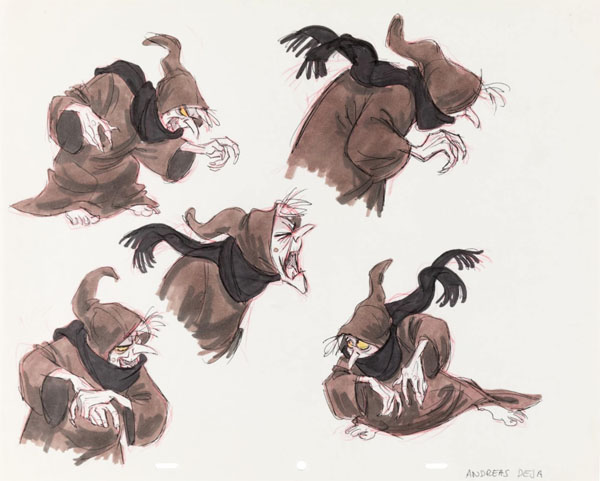
The voice for Orgorch was actress Billie Hayes, who played a funny but fearful witch character who desperately schemed to steal a magic flute on a popular children’s television show nearly a decade earlier when production on the animated feature originally began, and was a favorite of some of the young Disney animators.
That show was Sid and Marty Krofft’s H.R. Pufnstuf where she played Witchiepoo. This feature was her first voice work for an animated character but it led to a career doing it for The Nightmare Before Christmas, Johnny Bravo, The Batman, TaleSpin, Rugrats, Duckman, Darkwing Duck, Bonkers and many, many more credits. In her eighties, she was still voicing the long running role of Mrs. Neederlander in Transformers: Rescue Bots in 2016.
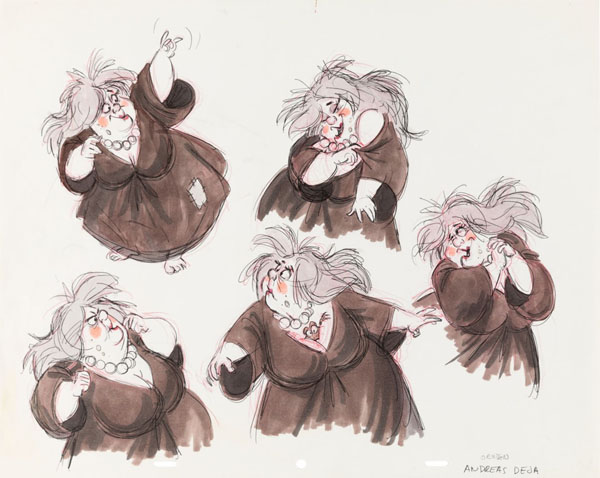
Girlishly plump Orwen, with her huge rolls of flesh cascading over her large body and her annoying giggle, appears to be the youngest of the group. She is the only one to wear make-up, but overdoes the pinkish cheek rouge and blood red lipstick so that it distracts from any natural attractiveness.
She is the only sister to wear jewelry, a necklace of oddly shaped asymmetrical blue stones, and frilly purple pantaloons under her dress. Unlike her fellow witches, this flirtatious sorceress is hopelessly and constantly lovestruck and decides her perfect mate is the hapless Fflewddur Fflam, the aged minstrel who is visibly repulsed by her too-abundant charms.
However, like her magical companions, Orwen should be greatly feared. The three of them have turned all humans who have unknowingly offended them into frightened little green frogs, and intend to do the same with the brave Taran and his compatriots for inadvertently releasing dozens of the imprisoned amphibians from a creaky old brown chest in the living room.
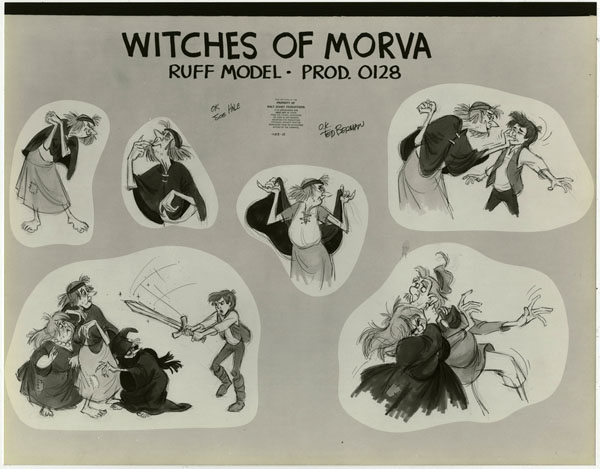
The three barefooted sisters, clad in loose, bluish colored garments, chatter quite jovially and casually about the most dreadful things—like dining on the transformed frogs—that frightens and unnerves the heroic band.
While the wicked inhabitants of the scary home retain some of the horrible whimsy of their literary counterparts, the adapted story in the animated feature, according to animation historian Brian Sibley, allowed “little or no time for them to be adequately established, let alone fully developed…it results in an almost lack of involvement [by the audience] with these delightful characters.”
One of the most important aspects that remained about these Morvaian mystics was their love of negotiating. Crafty Orddu exclaims with pride, “We never give anything away. What we do is bargain. Trade.” The two trades they arrange for the Black Cauldron are key pivotal moments in the final animated feature and, strangely, favor the heroes and what they need to live happily ever after.
Being supernatural, the trio also inhabit an ethereal plane high in the clouds where they casually lounge while observing the affairs of humans. They await the proper moment to exercise their mischief by projecting crackling blue light magical sparkles from their tapered white fingertips.
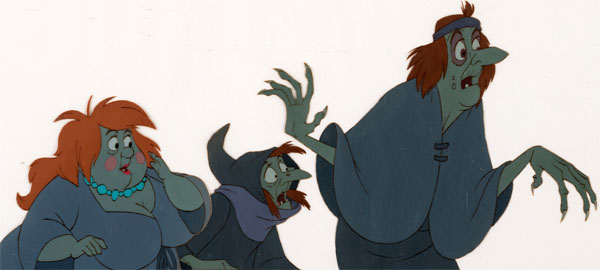
In the original book, the witches could transform themselves into beautiful maidens and, in fact, trade identities with each other—although none of them ever wanted to transform into disgusting Orgorch, who always had intestinal problems from eating too many toads.
Obviously, I am not the only one who remembers these obscure characters. In the Kingdom Hearts Unlimited Saga, they shape the events of the Keyblade Wars and the later Clone Wars from behind the scenes. They become invaluable allies in the fight against the Horned King, even going so far as to ally themselves with the exiled Jedi Sage, Count Dooku, as his primary squad of “witches”.
The energetic sorcery of these exuberant crones supplies an element of dark humor in the feature film that reminds audiences of the overwhelming forces that ill-equipped Taran and his friends will ultimately confront in their final battle with the Horned King. The lesson to be learned is avoid the Witches of Morva or you may end up croaking in more ways than one.


 Jim Korkis is an internationally respected animation historian who in recent years has devoted his attention to the many worlds of Disney. He was a columnist for a variety of animation magazines. With his former writing partner, John Cawley, he authored several animation related books including The Encyclopedia of Cartoon Superstars, How to Create Animation, Cartoon Confidential and Get Animated’s Animation Art Buyer’s Guide. He taught animation classes at the Disney Institute in Florida as well as instructing classes on acting and animation history for Disney Feature Animation: Florida.
Jim Korkis is an internationally respected animation historian who in recent years has devoted his attention to the many worlds of Disney. He was a columnist for a variety of animation magazines. With his former writing partner, John Cawley, he authored several animation related books including The Encyclopedia of Cartoon Superstars, How to Create Animation, Cartoon Confidential and Get Animated’s Animation Art Buyer’s Guide. He taught animation classes at the Disney Institute in Florida as well as instructing classes on acting and animation history for Disney Feature Animation: Florida.




















































Witches, like any number of cartoon characters (bears, little pigs, identical nephews), tend to come in threes, whether it’s the Graeae of Greek myth, the Weird Sisters in Macbeth, or the Trix in Winx Club. And so, The Black Cauldron….
I have very fond memories of this film. I saw it with a friend who was a huge fan of the Lloyd Alexander novels, and I couldn’t help but get caught up in his excitement. It was the first new animated Disney feature I had seen on the big screen since “The Jungle Book”, and I was enthralled. I loved the story, the animation, the backgrounds, and the music (Elmer Bernstein’s only score for an animated film). I felt sure that, with “The Black Cauldron”, the Disney Renaissance had well and truly begun. Well, it wasn’t the first time I was wrong about something, and it wouldn’t be the last.
Having seen it a number of times on home video, I think the main problem is the sense of anticlimax caused by the cuts Jeffrey Katzenberg made because small children were frightened by the dead army at a test screening. It wasn’t a kids’ movie anyway; Disney was targeting a more mature audience for the first time. Scenes like, for example, the one where Fflewddur (as a frog) gets stuck in Orwen’s cleavage, would never have happened in any previous Disney film. If the final battle had had something of the gruesome intensity of the witches’ sabbath in Fantasia, “The Black Cauldron” might be remembered more favourably. I hope someday the excised footage will be restored.
Elmer Bernstein also scored Heavy Metal, FWIW ..
So he did. Thanks! I’ve never seen it but will have to check it out now.
I saw the film. 10 minutes after, I hadn’t remembered a thing about it.
Maybe it would have been a good thing to consult, then. I, for one, saw it and remembered it vividly for years. Still do.
You can’t leave out Kathy Zielinski’s anecdote, when as a young animator she was instructed by the aged director Ted Berman, little experienced in working with women animators, to draw the transformed Fflewdurr bouncing around in Orwen’s “jugs”, as he put it.
I just watched the film a second time a couple weeks ago. Despite the hate it’s gotten from the critics, there’s a lot of great things in it. It’s just a little grotesque (for a Disney feature) and some of it is only a little underdeveloped (much like most Disney features after Disney’s death).
The witches are indeed fun characters (much more delightful than Madame Mim) There are some missed opportunities to do more with them, but they did well with Orwen and her attraction to Fflewddur.
I’m glad to see these articles about the less critically acclaimed Disney films. Hopefully we’ll see some sort of art book on this obscure gem.
The Hecateae. Three witches in one, eating frogs… a possible influence on Neil Gaiman’s Sandman.
Or it could just be the three good fairies from “Sleeping Beauty” redesigned for darker purposes.
Either way, you can’t have one without the others.
I remember seeing The Black Cauldron in my youth, and while it was definitely darker than other Disney animated fare, I remember it being not the most memorable or developed of features. Perhaps I should re-watch it at some point to see what I think about it now, maybe even read the original books and see how they compare. I will say the Witches of Morva were definitely one of the more memorable moments of this feature.
The production history of The Black Cauldron is definitely a fascinating one worth talking about. It’s interesting to look through the credits to see who all worked on it, since many of them would go on to make names for themselves in the industry, and especially at Disney.
I remember the Apple IIGS videogame more than the movie, which I never watched until I was an adult. I didn’t hate it but even without the benefit of having read the books, I noticed some story problems undoubtedly made worse in post-production. The biggest one seems to be the ambiguity over what the cauldron actually does. The Fairfolk scene is such an example. The remastered region 1 DVD (with an anamorphic transfer) has a storyboard that actually does a better job of making the case for why they should help Taran and Eilowny.
And speaking of them, I retroactively noticed after having grown up with the show that Cavin and Calla from The Gummi Bears looked like younger versions of this film’s two protagonists. Eilowny herself could have been Princess Aurora’s younger sister, which is just as well because of the fact that both this and Sleeping Beauty were shot in Technirama.